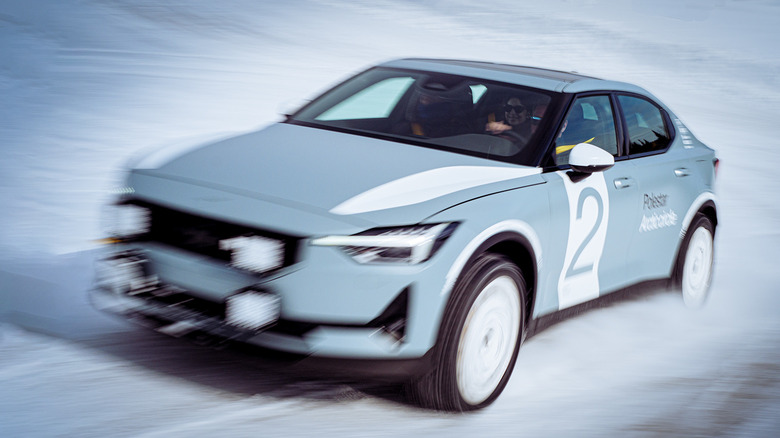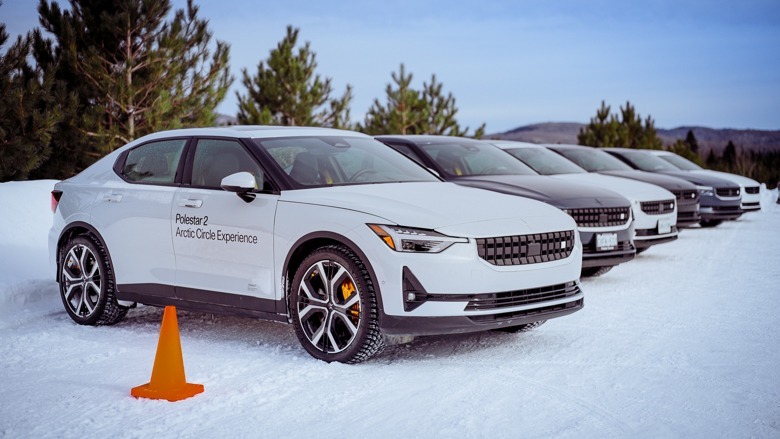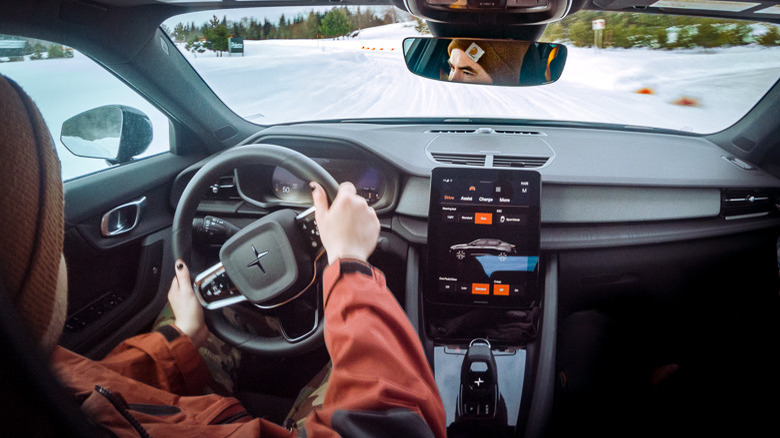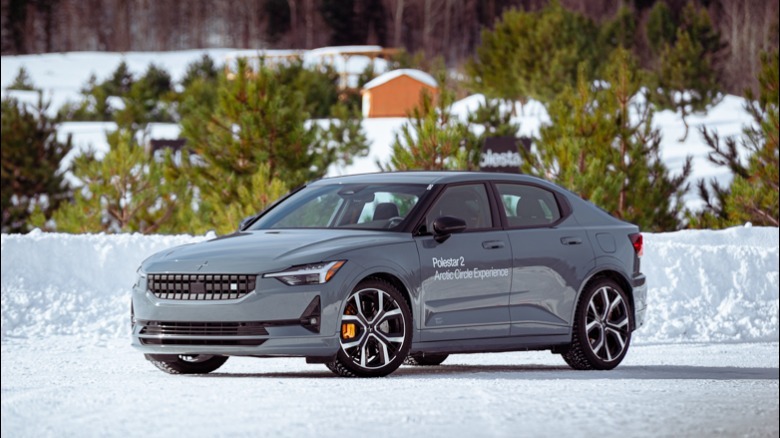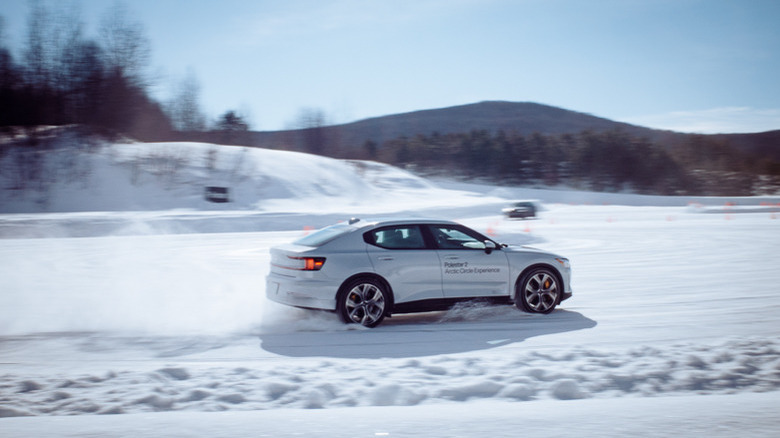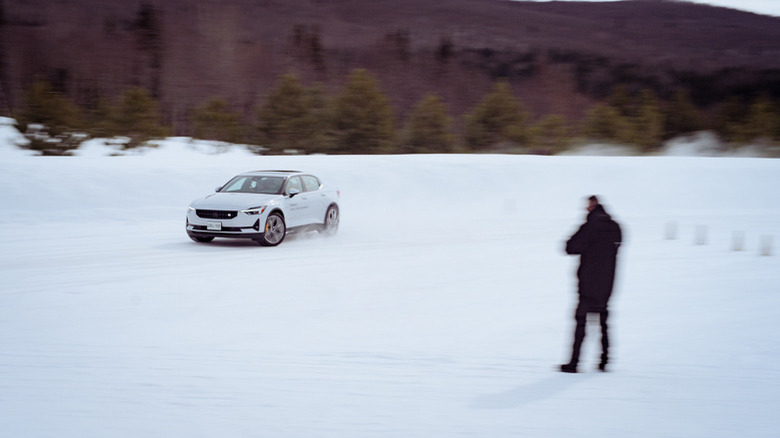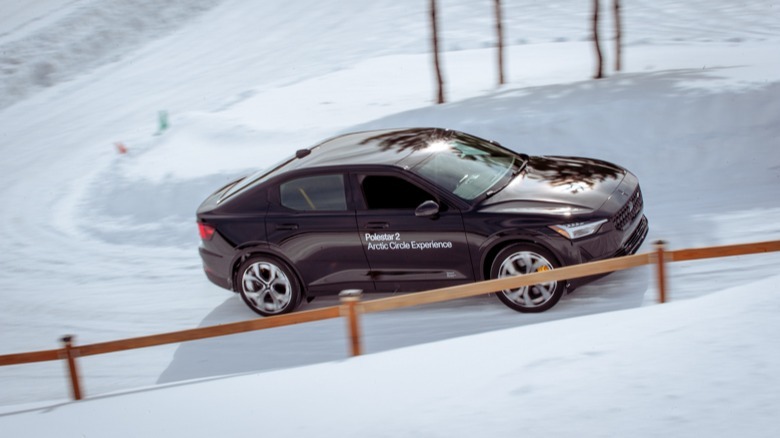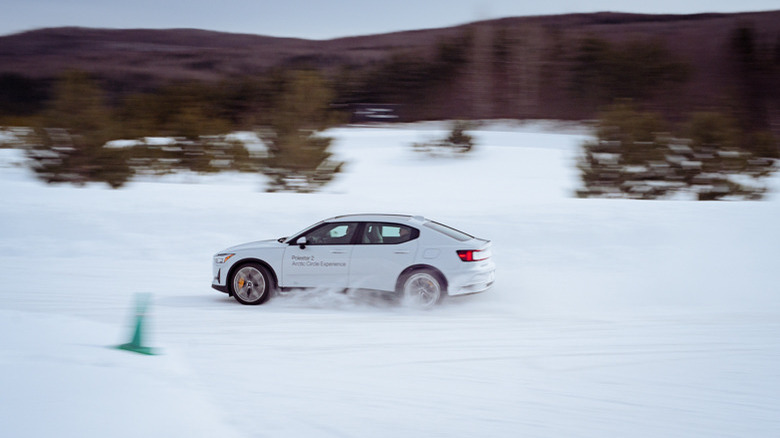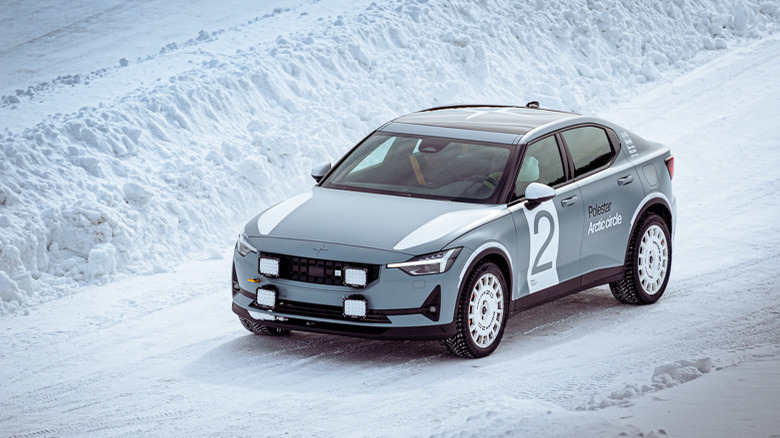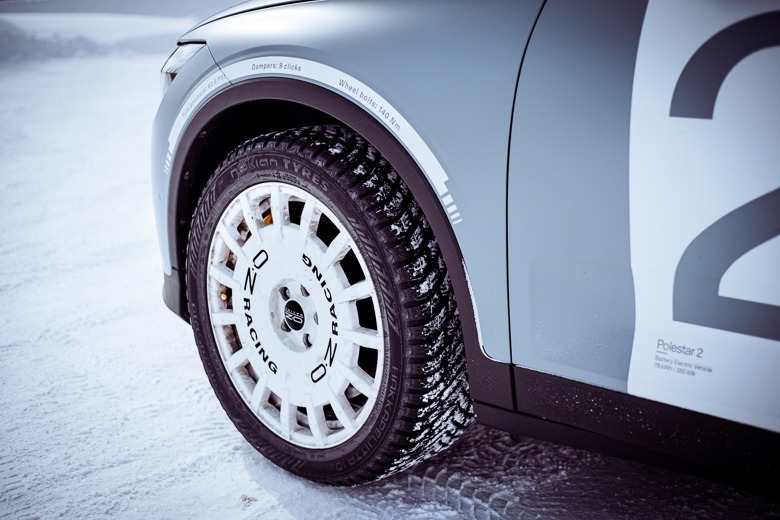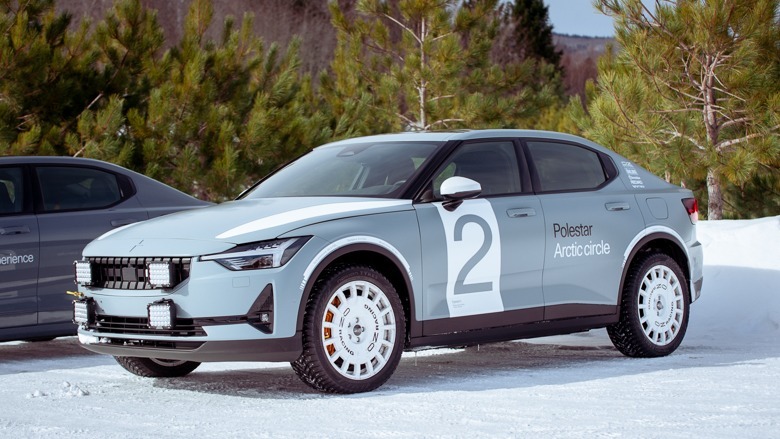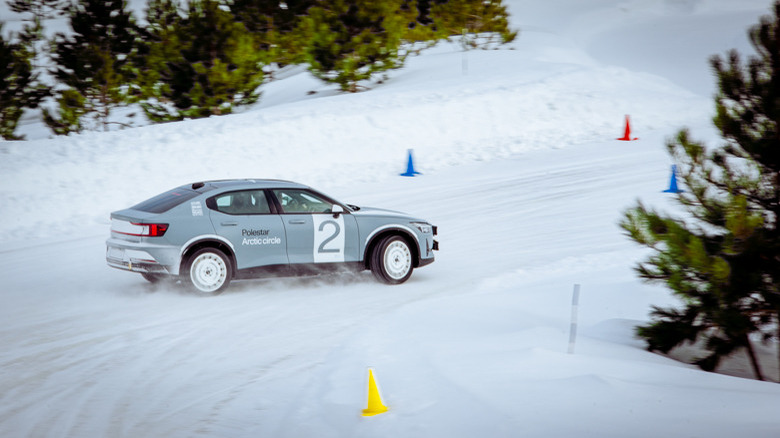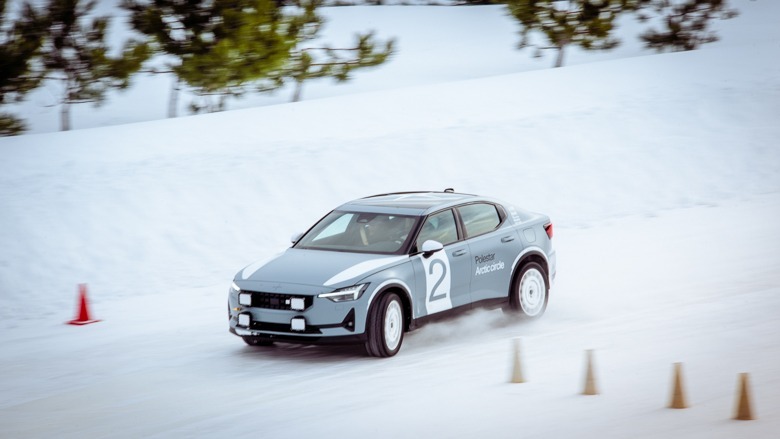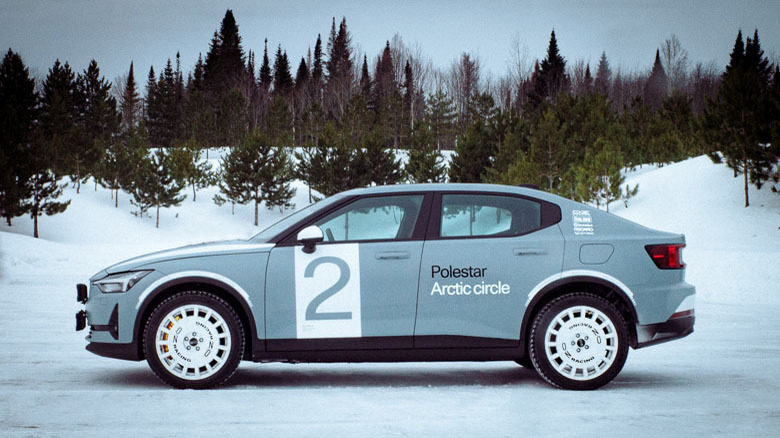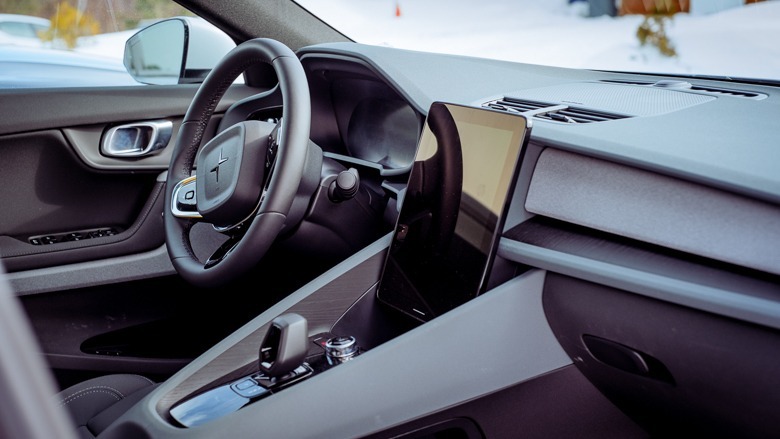Driving The Only Polestar 2 Arctic Circle Ever Made Teaches You One Very Important Lesson
In late February, Polestar invited SlashGear up to Canada to test their Polestar 2 electric vehicle in cold, snowy conditions. The stage was prepped at the Circuit Mécaglisse rally park outside of Montreal, Quebec, and the Mécaglisse crew took special care to get the powdery snow in ideal shape for loose-surface driving. Facing that surface was both the production Polestar 2 on winter tires, as well as the automaker's Arctic Circle prototype, a specially-modified rally version of the EV.
It began one chilly Tuesday morning. As the sun was just rising, we made about an hour's trip from a small lodge in the Quebec countryside, out to the track. Once at the circuit, we had to swap vehicles to ensure that not one spec of road salt would make its way onto the prepped surface. That's how serious this crew is about their snow, and it's probably the cleanest snow that I've ever seen outside of a post card. With uncontaminated production Polestars and fully-charged batteries, we made our way to first stage of the winter driving course.
Stage 1 - Beginner Course (100% Battery)
This route was intended to ease us into snow driving, and I appreciated it. I live in South Carolina, so I'm driving in snow maybe once a year at most: Quebec's environment may as well be another planet. This was also my very first opportunity to get acquainted with the Polestar 2. Luckily, they had the good sense to put the steering and pedals in the same place as any old gas-powered car.
The first course didn't contain any hairpin turns or slick slaloms, just gentle sweeping turns. I found this to be ideal, and I could test how much torque the surface was comfortable with just before understeer really set in. My driving instructor gave some input along the way, telling me exactly how the weight would transfer under braking and acceleration.
The Polestars we tested were dual motor cars with the Performance Pack upgrade. The package includes a power increase, large Brembo brakes, and yellow accent seatbelts. Combined output is 476 horsepower and 507 pound-feet of torque. However, the loose road surface and conservative traction control system in the Polestar 2 meant that not a lot of that torque was reaching the ground. The motor regeneration also made driving interesting, because letting off the throttle would decelerate me almost as much as the Brembos. At lower speeds, one-pedal driving is totally possible.
Stage 2 - The Skid Pad (83% Battery)
After the little jaunt in the beginner course, we quickly made our way to the circuit's skid pad loop. Here, we were allowed to turn the Polestar's traction control off, and let the full torque loose. I don't know if the last stage adequately prepared me for this one. I've done skid pad before, but only in water with a rear wheel drive car. Everything happens a little bit differently when you've got those front tires clawing for traction, too. In theory I was meant to coast gently up to a cone in the center of the ring, put the power down, and carry an oversteer across to the other side. The ultimate goal was to make a full loop around the pad without any interruption.
Theory is one thing; reality is quite another, and it turns out skid pad driving is a lot like how I assume floating in zero gravity is. Conventional driving rules go out the window, and it's easy to lose your orientation in the middle of slide. Once I hit the oversteer, the Polestar would begin to slide almost 180 degrees backwards. My muscle memory would instinctively read this as something wrong and I'd go for the brake, but really you should be letting the power flow through the whole slide. I spun out more times than I can remember, but by the end I was able to complete a couple decent loops.
Stage 3 - Advanced Course (76% Battery)
While we were on the skid pad, the Mécaglisse staff reconfigured the driving course into a more complex configuration. This stage included some more difficult maneuvers like a slalom and hairpin turns. It also showed us the effects of tires on fresh snow: by this point in the day, our tires were polishing the tracks surface and creating a slippery coating of ice. It could only make driving difficult with each succeeding lap. This course also presented an opportunity for us to unlearn some previous driving habits.
When it comes to track driving, I'm much more used to dry pavements and cars with plenty of front end grip. In those conditions, you're supposed to brake hard on turns and crank the steering wheel aggressively in order to attack the apex of the turn. This technique simply does not work on snow. Turn in too tightly and the front tires will give you nothing but understeer. The snow requires gentle input at your hands and feet. I also found that the traction control was kicking in very hard on these sharp corners and allowing very little torque to leave the Polestar's motors. Overall, this course was a significant ramping up in difficulty from our early morning drive.
Stage 4 - The Scandinavian Flick (62% Battery)
Things only got more difficult from there, tasked with applying an advanced driving technique known as the "Scandinavian Flick." Reportedly invented by Finnish rally racers in the 60's, the flick demands that you decelerate while approaching a corner, while at the same steering hard toward the apex. This transfers weight to the front of the vehicle while making the rear comparatively lighter. The driver then quickly gets back on the accelerator quickly, applying counter-steering to carry a controlled drift through the turn.
It's one of the fastest ways around a corner in dirt or snow, and it's commonly used by pro rally drivers. However, it's not so commonly used by writers. The result was many high-speed wipeouts from all the driver groups. Luckily, the only thing to hit on the course were a few cones and mercifully soft snow banks. This course contained a few corners that were similar to the last stage, but at the end opened up into a large slalom where we were challenged with performing the flick.
It took me no time to figure out the weight transfer portion of the technique, but the powerslide portion was more difficult. Half the time I attempted to put the power down, the traction control would deaden throttle output and I'd just get more understeer. The Polestar 2 required me to more gently apply the accelerator to coax that power out correctly. After five or six attempts at the Scandinavian Flick, I managed to carry a gentle drift through the whole turn and quickly straighten out on the other side. My instructor rated it an 8.5, which I consider more than acceptable.
The Polestar 2 Arctic Circle
As part of the winter driving event, the automaker also brought out its one-off Polestar 2 Arctic Circle prototype to the track. Plenty of manufacturer show cars are glorified rolling statues, but this is not the case with the Arctic Circle. It shares plenty of features with the production Polestar 2, but also gets a suite of rally-inspired mods, like studded Nokian snow tires on lightweight 19-inch OZ Racing wheels. Custom Öhlins dampers have been fitted that provide a higher and softer ride compared to the factory car.
Software tuning also gives it a more lenient traction control system, and a slightly lower power output compared to the performance pack. Horsepower is rated at 469, with 502 pound-feet of torque. Aesthetic mods include LED fog lights, tow hooks, and deep bucket racing seats. It also receives a subtle blue-gray paint tone that looks fantastic against the stark white snow. At the end of our day, Polestar put me in the driver's seat of the Arctic Circle to see how it compared to the factory car.
I hate to throw undue shade on the production Polestar 2. It did the best it could in these conditions, but the Arctic Circle driving experience was several magnitudes better. It's not too surprising, considering the one-off was modified specifically for this driving environment. Nothing made that more clear than re-running the Scandinavian Flick course from the event prior.
Stage 4.5 - Driving The Polestar 2 Arctic Circle
Almost immediately upon getting in the Arctic Circle, my nervousness about winter driving melted away, replaced by perhaps unearned confidence. The Scandi' Flick course by this point had been thoroughly beaten down by dozens of laps, but the studded Nokian tires effortlessly found grip. The upgraded suspension also made it much more simple to feel weight transfer, and the higher output motors with lax traction control always kept the power on tap.
Even while the rally tires were spinning, they could maintain enough grip to dance on the edge of traction without wiping out. For the few minutes I was in that Polestar, I could semi-convincingly cosplay as Colin McRae or Sébastien Loeb. It was truly like driving on easy mode. Plus, the car just looks so cool. It almost makes me want to max out every credit card and build a rally racer of my own.
Unfortunately, Polestar has no plans to offer the Arctic Circle up to customers, and you can't even buy that specific tire off the rack. If it's any consolation, the standard Polestar 2 would likely be very practical in everyday winter driving. Nokian also makes a Hakkapeliitta 10 studded tire that will fit the factory 20-inch wheels on the Polestar.
Final Thoughts
After the whole day, our production Polestar 2s were sitting at about 50% battery. Not too bad considering that we'd been doing nothing but hard driving and blasting the heater to keep warm. Getting to drive both versions of this car, one thing becomes really apparent: tire selection is likely the most important factor when it comes to performance driving on loose surfaces. That's very conventional wisdom, and it's conventional for a good reason. No amount of torque will do you good in a chassis when traction fails and you can't utilize it. If our Polestar 2s were prepped with, say, all-season tires, they would've been completely worthless on the course that day. On the other hand, the rally tires on the Arctic Circle prototype turned that car into a rock star.
The 2023 Polestar 2 single motor starts with a base MSRP of $48,400, though there may be tax rebates available in your area to bring the effective price down lower. The dual motor with all wheel drive comes at a slight premium, at $51,900. The performance pack car as-tested will run $57,400. On the street, full battery range is rated at 270 miles for the single motor Polestar 2m and 260 miles for the dual motor. Just remember to budget for the right rubber, too.
